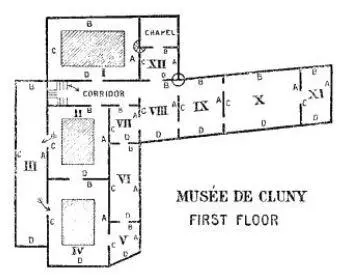Grant Allen - Paris. Grant Allen's Historical Guides
Здесь есть возможность читать онлайн «Grant Allen - Paris. Grant Allen's Historical Guides» — ознакомительный отрывок электронной книги совершенно бесплатно, а после прочтения отрывка купить полную версию. В некоторых случаях можно слушать аудио, скачать через торрент в формате fb2 и присутствует краткое содержание. ISBN: , Издательство: Иностранный паблик, Жанр: foreign_language, foreign_prose, на английском языке. Описание произведения, (предисловие) а так же отзывы посетителей доступны на портале библиотеки ЛибКат.
- Название:Paris. Grant Allen's Historical Guides
- Автор:
- Издательство:Иностранный паблик
- Жанр:
- Год:неизвестен
- ISBN:http://www.gutenberg.org/ebooks/49907
- Рейтинг книги:4 / 5. Голосов: 1
-
Избранное:Добавить в избранное
- Отзывы:
-
Ваша оценка:
- 80
- 1
- 2
- 3
- 4
- 5
Paris. Grant Allen's Historical Guides: краткое содержание, описание и аннотация
Предлагаем к чтению аннотацию, описание, краткое содержание или предисловие (зависит от того, что написал сам автор книги «Paris. Grant Allen's Historical Guides»). Если вы не нашли необходимую информацию о книге — напишите в комментариях, мы постараемся отыскать её.
Paris. Grant Allen's Historical Guides — читать онлайн ознакомительный отрывок
Ниже представлен текст книги, разбитый по страницам. Система сохранения места последней прочитанной страницы, позволяет с удобством читать онлайн бесплатно книгу «Paris. Grant Allen's Historical Guides», без необходимости каждый раз заново искать на чём Вы остановились. Поставьте закладку, и сможете в любой момент перейти на страницу, на которой закончили чтение.
Интервал:
Закладка:
The centreof this room is occupied by several good statues. Examine each; the descriptive labels are usually sufficient. (A noble *St. Catherine; St. Barbara with her tower; St. Sebastian, pierced with the holes where the arrows have been; a beautiful long-haired wooden Madonna; a fine [Pisan] Angel of the Annunciation, in wood, etc.) Also, several excellent figures of Our Lady. The large part played by the Madonna in this Room, indeed, is typical of her importance in France, and especially in Paris, from the 13th century onward. The church of Notre-Dame is partly a result, partly a cause, of this special cult of the Blessed Virgin.
Room VII (beyond the corridor, a modern covered courtyard). — Tapestries and textile fabrics, interesting chiefly to ladies. On Wall A, and others, Flemish tapestry, representing the History of Bathsheba, much admired and very ugly; compare it with the tapestry of the Lady and the Unicorn, to be visited later in Room III, upstairs, contrasting them as models of what such work should and should not be. Wall B, admirable Renaissance relief of the Cardinal Virtues. Above it, a good Madonna, and figures of Grammar and Astronomy. Wall C, Caryatid of inferior art, French, 16th century. **(448), Admirable group of the Three Fates, attributed to Germain Pilon, the great French sculptor of the 16th century, whom we shall meet again at the Louvre – a fine specimen of the plastic art of the Renaissance, said to represent Diane de Poitiers and her daughters. Below **(447), exquisite Renaissance bas-relief of the huntress Diana, of the School of Jean Goujon, again in allusion to Diane de Poitiers. (478) Good mask of the same epoch. (251) Virgin and Child, meretricious; in the decadent style of the 16th century; very French in type, foreshadowing the Louis XV spirit – the Madonna resembles a little-reputable court lady. Wall D(463, etc.), Judgment of Solomon, Solomon and the Queen of Sheba, Annunciation, and other reliefs in the florid and least pleasing French style of the 16th and 17th centuries. Table by the doorway **(449), exquisite small marble statue of the Deserted Ariadne (perhaps Diane de Poitiers), in the best Renaissance manner, probably by Germain Pilon: found in the Loire, near Diane’s château of Chaumont. Beside it, three sleeping Venuses, one of which is also said to be Diane de Poitiers, the goddess of the Renaissance in Paris. L of doorway (457), singular marble relief of Christ and the Magdalen after the Resurrection (Noli me tangere); the Saviour strangely represented (as often) in a gardener’s hat and with a spade; in the background, angels by the empty sepulchre; Flemish, florid style of the 16th century. Beside it (467 and 468), two exquisite Renaissance reliefs of Venus. In front of it, on the table *(479), Entombment, with the body of Christ placed in the sarcophagus by Joseph of Arimathea and Nicodemus – portraits, I think, of the donors.
Room VIII – Textile fabrics and ecclesiastical robes. Wall B, L of door (487), pretty but meretricious little group of Venus and Cupids, with grapes, French style of the 17th century; the national taste still more distinctly showing itself. R of door (459), in two separate figures, a quaint Annunciation – French, 16th century, frankly anachronistic. Close by (464), the Judgment of Solomon, same school and period. Above (563), clever small alabaster group of the Rape of the Sabines, after Giovanni da Bologna. These all stand on a handsome French carved chest of the 16th century. Wall C, greatly worn altar-relief of the Adoration of the Magi, from the chapel of the Château d’Anet, French Renaissance, 16th century. Above it (446), Mary Magdalen, kneeling, with long hair and the alabaster box of ointment – her symbol in art – 15th century, curious. At the back, gilt and painted figures of the Holy Trinity, from the demolished church of St. Marcel at Paris, 17th century. Similar representations of the Trinity, showing the three Persons thus, are common in Italian art. Further on (493), good figure of a shepherd, French, 16th century. Wall A(266), curious altar back, Herod ordering the Massacre of the Innocents. (267) St. Eustace crossing the river (see Room VI) with the lion and the wolf seizing his children. A very different treatment from the previous one. (291) A lintel of a chimney, Flemish, dated 1555; centre, a river-god; L and R, pelican and eagle; between the figures, Faith, Hope, Charity and Prudence. (273) Madonna and Child (Notre-Dame de l’Espérance, throned on an anchor). On the wall, far L, interesting piece of French 14th century tapestry, with a legend of St. Marcel and St. John Evangelist, most naïvely represented.
Room IX. – State coaches and Sedan chairs of the 17th century, as ugly as can be imagined. They need not detain you.

MUSÉE DE CLUNY FIRST FLOOR
The staircaseto the FIRST FLOOR is in the Corridor to Room VI. Observe the staircase itself, in carved wood, bearing the arms of France and Navarre, and also the crowned initials of Henri IV and Marie de Médicis. It was formerly in the old Chambre des Comptes of Paris, and was re-erected here at the installation of the Museum.
The corridorabove contains arms and armour. At the head of the staircase (742), very quaint Magdalen in wood with the box of ointment; German in style, 15th century; observe her long hair, here twisted and plaited with German neatness. (1466 and 1468) Renaissance cabinets in ebony.
Room I. – Gallery, looking down on the courtyard of Room VI, below. Wall D, by which you enter; tiles, French Renaissance. Wall C: first case, blue Flemish stoneware. Fine wrought-iron gates, gilt. In front of them, female Satyr, French, 18th century, very characteristic of the national taste; opposite it, male Satyr, the same. Second case: Palissy ware, French 16th and 17th centuries. This fine ware is full of Renaissance feeling. Notice particularly (3140), a Sacrifice of Abraham; (3145) the Baptism in Jordan, conventional treatment; (3139) Judith and Holofernes, with several other scriptural scenes in the older spirit; intermingled with these are classical and mythological scenes, displaying the growing love for the nude; observe particularly (3119), a Venus with Cupids; and another dish below it, unnumbered, same subject; also, a Creation of Eve; (3131) Susanna and the Elders, and other scenes of similar character. Observe that while the early work is purely scriptural or sacred, the Renaissance introduces classical subjects. Note too the frequent scenes of the Baptism in the same connection. Centre (3102), beautiful vase with lid, of the period of Henri II. Study all the Palissy ware. Wall B, French pottery of the 18th century, exhibiting the rapid decline in taste under Louis XIV and XV, especially as regards colour. The most satisfactory pieces are the blue and white dishes with royal monograms, arms, etc. Second case: Rouen ware of the 18th century, far superior in style and tone to the preceding. Good nude figure of Venus. Wall A, Nevers pottery, delicate blue and white; (3338) figure of a page, to support a lamp. Last case: Dutch pottery, Delft, 18th century, exhibiting the strong domestic Dutch tendency.
Room II. – Also galleries, surrounding a courtyard. Exquisite Italian Renaissance pottery. Wall B, R of entrance, beautiful Italian specimens of Faenza ware, 15th and 16th centuries (whence the word faïence ); these should be closely studied in detail. (2811) Quaint dish with Diana as archer; beside it, portraits. (2824 and 2825) Decorative plaques with heads of women. (3949) St. George and the Dragon in green pottery. Behind it, plate with admirable portrait. In the same case, Judith receiving the head of Holofernes; (3024) Hercules playing the lyre to entice Auge. Wall C, first case, Deruta and Chaffagiolo ware of the 16th century. Exquisite decorative dishes and plaques; (2814) Actæon changed to a stag by Diana. (2849) Susanna and the Elders. (2887) St. Jerome in the desert, with his lion. (2895) The doubting Thomas. (2823) Another Actæon. Observe frequent repetition of certain scenes. Fine plates with arms of Medici Popes, etc. Second case: Deruta ware, still more splendid specimens, many of them with remarkable lustre. (2894) Madonna and Child, with infant St. John of Florence. Other plates with Mercury, a sphinx, a lion, the huntress Diana, a Moor’s head, portraits and decorative designs. Examine in detail. Wall D, first case, Casteldurante and Gubbio ware, 16th century (3007) Manius Curtius leaping into the Forum. (3015) Crucifixion, with the sun and the moon darkened. (3004) Dædalus and the Minotaur. (3008) Fine conventional design. Other plates have heads of St. Paul and mythological persons. (2802) a quaint Temptation of St. Antony. (2818) Leda and the Swan, etc. Second case: Urbino ware, 17th century. Head of Raphael, and delicate Raphaelesque scenes, instinct with the later Renaissance feeling. (2961) Perseus and Andromeda. (3064) Expulsion from Paradise; on either side, Temptation, and Adam eating the fruit. (2872) a Baptism in Jordan. Notice again the mixture of religious and mythological scenes, with a preference for those where the nude is permissible – Judith and Holofernes, Orpheus, etc. Wall A, fine Florentine terra-cotta bust of the young St. John, patron saint of the city. More Urbino ware, to be carefully examined. The greater part of this wall, however, is occupied by **Della Robbiaware, glazed Florentine majolica of the 15th and 16th centuries. (2794) Fine figure of St. Michael. (2799) Martyrdom of St. Catherine, the wheels of her torture broken by angels. Above it, Madonna adoring the Child; observe in this and many other cases the beautiful setting of fruit and flowers, characteristic of the Delia Robbias. Beneath, no number, the Beheading of St. Catherine; in the background, angels conveying her soul to Heaven. (2795) The Infant St. John, patron Saint of Florence. (2793) Temperance, with flagon and patera. Then, more Urbino ware, very fine examples of the end of the 16th century; above them, touching Madonna and Child, Della Robbia. Wall B, again, Castello ware, and Venetian pottery, 15th, 16th and 17th centuries. Apothecary’s jars, plaques, etc., extremely beautiful.
Читать дальшеИнтервал:
Закладка:
Похожие книги на «Paris. Grant Allen's Historical Guides»
Представляем Вашему вниманию похожие книги на «Paris. Grant Allen's Historical Guides» списком для выбора. Мы отобрали схожую по названию и смыслу литературу в надежде предоставить читателям больше вариантов отыскать новые, интересные, ещё непрочитанные произведения.
Обсуждение, отзывы о книге «Paris. Grant Allen's Historical Guides» и просто собственные мнения читателей. Оставьте ваши комментарии, напишите, что Вы думаете о произведении, его смысле или главных героях. Укажите что конкретно понравилось, а что нет, и почему Вы так считаете.












